Volume 2/ Hip Mobility in the Golf Swing
Hip mobility is the ability to control the movement of the hips through a desired range of motion, and is an important part of many athletic endeavours, including golf. Taking a golf stance, performing a golf swing, walking the golf course, and even picking up your golf ball require varying degrees of hip mobility.
Throughout the golf swing the hips are required to flex, rotate inwards, rotate outwards, move in, move out, and extend. All of these hip movements are performed as a result of the many muscles that surround the hip joint. These muscles contract and relax to initiate movement, and work in conjunction with other parts of the body. Improving hip mobility may allow for a golf swing with a greater range of motion, and overall efficiency.
"Hip mobility generates power"
Hip mobility is also important because it allows us to obtain an optimal position to generate power. The ability to control the movement of the hips allows for power to be generated and transferred across the body and applied to the golf swing.
The lower back is made to move in an array of motion, but over time can become sensitive to different positions and motions. This is especially true as it relates to golf which typically involves a high degree of low back twisting and bending. Focusing on hip movement and improving hip mobility will help reduce some of the pressure placed on the lower back.
"Increased hip mobility will reduce some of the pressure placed on the lower back."
There are many options when it comes to addressing how your hips move including; stretches, mobilizations, and strengthening exercises. You can find a series of exercises below focused on active hip mobility coupled with thoracic rotation, and core stability. All of which are important aspects pertaining to golf and overall health.
Watch the FULL VIDEO here:
Volume 1/ Golf and Thoracic Spine Mobility
After a long winter the prospect of hitting the golf course is exciting! When it comes to golf there are many moving parts that can impact one’s performance, pain, and enjoyment. Over the course of the next several months I will focus on specific areas of the body that may be holding BACK your golf game.
Throughout our daily lives we often find ourselves repeating similar tasks day in and day out seldom performing a variety of motions, working different muscles, and challenging our movement abilities. The saying “use it or lose it” applies here. If you feel you might have lost it, don’t worry! Movement can be regained, muscles strengthened, and abilities challenged.
When performing a golf swing the body goes through an array of motion. The body flexes, extends, rotates, and bends side to side. That’s a wide variety of movement all going on within a short and fast sequence. On the golf course these movements are performed repeatedly, on varying surfaces, and at a high rate of speed requiring sufficient mobility and stability throughout the body.
The first blog post we will take a look at how the upper/mid back can impact your golf game.
Your upper/mid back is composed of 12 vertebra and called your thoracic spine. Your thoracic spine serves as an attachment point for your ribs, muscles, and allows for varying ranges of motion, primarily bending and rotating.
When performing a golf swing a certain amount of torso rotation and extension is required. Ideally some of this rotation and extension motion will occur through your thoracic spine. When performing the back-swing phase of a golf swing, the thoracic spine extends and rotates; the shoulders, arms, hands, and golf club follow suit traveling in an arc behind the body. In order to maximize swing speed a golfer stabilizes the low back and pelvis, while generating movement through the thoracic spine. This creates a wind-up effect which can increase muscle stretch and contraction causing an increase in swing speed. A swing with adequate thoracic spine range of motion and low back/pelvic stability may not get you on the PGA tour, but it could help add a few extra yards to your golf game.
Improving swing speed is great and all, but what about THE PAIN? Thoracic spine mobility can play a part in reducing undue strain and pain on other areas of the body particularly the shoulders, neck, and low back.
As mentioned the thoracic spine is one of many areas of the body that is required to extend and rotate when performing a golf swing. If the thoracic spine does not go through adequate extension and rotation, the body adapts and finds a different region of the body to generate movement through. When the low back and shoulder do not have adequate strength and stability we may produce further movement through the low back and shoulder to make up for a lack of movement through the thoracic spine. With an increase in the demands placed on these areas they may become sensitive over time leading to nagging injuries and time spent off the golf course.
With that being said there are some simple exercises that can be done to improve thoracic spine range of motion, and promote low back stability. These exercises are great to do any time especially prior to the golf season, and/or as part of a warm-up before hitting the course or driving range.
Below are some links to exercise videos with descriptions to some examples of exercises that can be used to improve and maintain thoracic spine motion. There are many exercise variations, progression, and regressions that can be used. Pick a few you can perform within a tolerable range, and get moving!
Dr. Brett O'Drowsky | Stonetown Physiotherapy
Thoracic Spine Mobility Exercises
1/ Thoracic Cat Camels
This is an exercise variation where we are focusing on thoracic flexion and extension. When performing this exercise the thoracic spine movement can be quite subtle with. See video demonstration with instructions for thoracic cat camel exercise here.

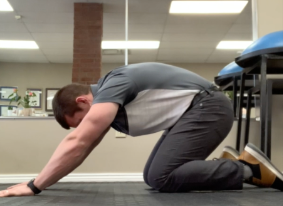
2/ Thoracic Extension Mobilization
This exercise focuses on thoracic extension and stretching the lats, which are the big wing like muscles on the outside part of the back that can often be tight. With this exercise we are also looking to stabilize the low back while focusing on movement of the upper back. See video demonstration with instructions for thoracic extension mobilization exercise here.

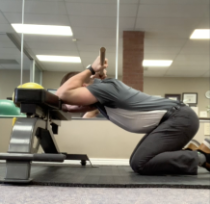
3/ Quadruped Thoracic Rotations
This exercise is great for focusing on stabilizing the low back while emphasizing thoracic rotation and thoracic extension. These movements are both important throughout the golf swing. See video demonstration with instructions for quadruped thoracic rotation exercise here.
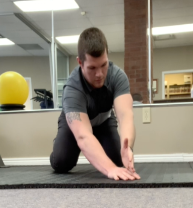
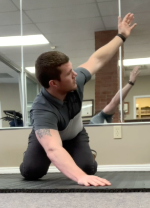
4/ Standing Thoracic Rotations with Hip Hinge
This exercise is great for working on active low back/hip stabilization while performing thoracic rotation. This exercise brings us to our feet and can be challenging to coordinate the upper back movement while maintaining low back/hip stability. See video demonstration and instructions for standing thoracic rotation with hip hinge exercise here.
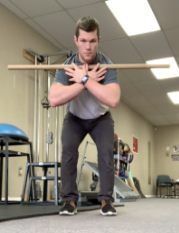
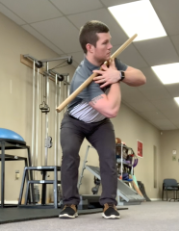
References
1) Cole MH, Grimshaw PN. The Biomechanics of the Modern Golf Swing: Implications for Lower Back Injuries. Sports Med. 2016 Mar;46(3):339-51. doi: 10.1007/s40279-015-0429-1. Review. PubMed PMID: 26604102.
2) Lamb PF, Pataky TC. The role of pelvis-thorax coupling in controlling within-golf club swing speed. J Sports Sci. 2018 Oct;36(19):2164-2171. doi: 10.1080/02640414.2018.1442287. Epub 2018 Feb 23. PubMed PMID: 29471731.
3) Tinmark F, Hellström J, Halvorsen K, Thorstensson A. Elite golfers' kinematic sequence in full-swing and partial-swing shots. Sports Biomech. 2010 Nov;9(4):236-44. doi: 10.1080/14763141.2010.535842. PubMed PMID: 21309298.
